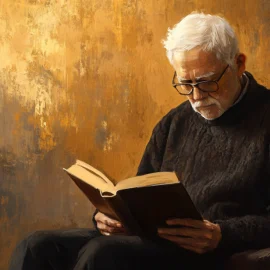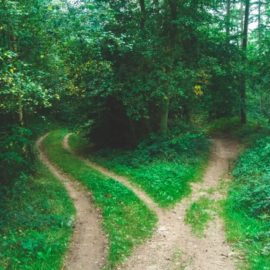
How do creative geniuses come up with their groundbreaking ideas? How can you better navigate the successes and failures that come with creative work?
In Creative Quest, Questlove, a musician and producer, explores the creative process, arguing that creativity isn’t an innate talent. He provides tips and strategies to access your creativity, collaborate with others, and overcome obstacles, so you can create work that you and others enjoy.
Continue reading for a book overview of Creative Quest.
Overview of Creative Quest
In Creative Quest, musician and producer Questlove explores the creative process, arguing that creativity isn’t an innate talent that some people have and others lack. Rather, creativity is something we can all boost by making our own creations or interacting with other artistic works. He provides tips and strategies to access your creativity, collaborate with others, and overcome obstacles, so you can create work that you and others enjoy.
Questlove (Ahmir Khalib Thompson) is a four-time Grammy winner and cofounder of The Roots, the house band for The Tonight Show. He also hosts the podcast Questlove Supreme. His experience extends beyond music and into film and academia: He made his directorial debut with the documentary Summer of Soul, which won both an Academy Award and a Grammy Award, and he teaches at NYU’s Tisch School of the Arts. Questlove’s other written works include Something to Food About, Music Is History, and his memoir Mo’ Meta Blues.
In this guide, we’ll explore Questlove’s ideas about creativity in four parts:
- In Part 1, we’ll discuss Questlove’s definition of creativity and the benefits of practicing creativity.
- In Part 2, we’ll explore Questlove’s tips for preparing to do creative work, such as how to get in the right headspace and plan your creative project.
- In Part 3, we’ll examine methods for getting and using creative inspiration, such as how to work with collaborators and choose artistic influences.
- In Part 4, we’ll look at how to handle both success and failure.
Throughout the guide, we’ll incorporate advice and practical tips from other creative thinkers that you can consider alongside Questlove’s ideas.
Part 1: What Is Creativity?
Questlove defines creativity as the process of making something new. He argues that being creative isn’t just something traditional artists do—everyone can be creative. A parent who designs fun activities for their kids can be just as creative as a professional filmmaker.
According to Questlove, creativity allows us to leave our imprint on the world. When we create something, we prove we can change our surroundings and make a difference in our communities and in other people’s lives. For example, if you’re an indie game developer, you can see how your games inspire people, give them comfort, or help them connect with friends.
Part 2: How to Be Creative
According to Questlove, you don’t need special training to be creative—you just need to practice using the skill and learn to trust your creative instincts. In this section, we’ll discuss how to be creative using tips like keeping your mind open to new ideas, setting up your workspace, planning creative projects, and maintaining your creativity as you age.
Keep an Open Mind
First, Questlove writes that the key to creativity is to let your mind remain open and receptive to ideas. You can do this by:
1. Accepting all ideas that come to mind. When doing creative work, it can be tempting to immediately judge ideas that pop into your mind as good or bad. But if you’re too quick to dismiss ideas, you might prematurely filter out valuable ones. You’ll also feel frustrated as you try to generate perfect ideas. Questlove argues that by entertaining your ideas longer, no matter how strange or far-fetched they may seem, you might discover connections you’d otherwise miss and also stay in a creative flow. To stay open to initial ideas, remind yourself that editing and refinement can come later.
2. Relaxing your mind. Research shows it’s easier to be creative when you’re slightly tired and unfocused than when you’re fully alert. This is because fatigue lowers your mental filters, allowing you to have more random thoughts and connections. To relax your mind, Questlove recommends taking small mindfulness breaks while you work: Step back from whatever you’re doing for 15 to 60 seconds. For example, if you’re stuck on a paragraph of your novel, take a short pause to reset your thinking. These breaks are short enough that you won’t disconnect entirely from your work, but they give your mind the space it needs to generate new insights.
Be Mindful of What Helps and What Hinders You
Second, to support your creativity, Questlove recommends being mindful of the things that comfort you and help put you in a creative mindset. He recommends getting rid of distractions without denying yourself the small pleasures that ground or soothe you. He explains that some people try to avoid distractions by avoiding small pleasures—whether it’s background music, snacks, or a sensory indulgence. However, he argues that denying yourself these small comforts is more distracting, since you’ll spend time longing for them instead of focusing on your work.
For example, if you’re hungry when working but force yourself to wait until dinner to eat, you might spend more time watching the clock and thinking about what you’ll eat later instead of focusing on your creative work. Having a small snack while you work prevents hunger from distracting you, helping you stay more focused and engaged in the creative process.
Plan Your Work
According to Questlove, you must also plan your creative projects. He argues that the most successful works incorporate elements of both planning and spontaneity. Having a plan gives you the necessary direction and purpose; however, following it too rigidly can make work feel stale and unoriginal. So, you must also leave room for unexpected choices that make your work fresh and exciting to engage audiences.
Questlove suggests two tips for planning your work:
1. Start with a basic plan. Carve out a general direction for your work, but stay open to ideas that might emerge during the creative process. For a writer, this might mean developing your plot points and character arcs but letting dialogue or scenes arise spontaneously as you write the story.
2. Imagine the final result of your work. Visualize how your work will be presented and how your audience will receive your work. Rather than trying to please everyone, focus on connecting with your specific audience. Even if your work speaks to a smaller group, it can have a powerful impact on those who truly connect with it.
View Creativity as a Journey
Lastly, Questlove writes that making creative work takes time and patience, so he suggests you view creativity as a lifelong journey. He argues that creators must work regularly on their craft, even when they don’t feel inspired. Some days you’ll feel excited to create, while on other days it might feel like a chore. Both types of days are normal and necessary. The key is to keep showing up and doing the work, knowing that mastery develops over time.
Questlove urges you to continue doing creative activities as you grow older because creative activities keep your brain sharp. Some people stop being creative because they think they’re too old or find it harder to do things they used to do, but giving up creative activities makes doing things harder.
To maintain your creativity as you age, Questlove suggests two strategies. First, spend time with younger people and learn about new trends—attend their concerts, look at their art, or join their book clubs. This exposure to fresh perspectives keeps your mind open to new ideas. Second, adapt your creative routine to match your current abilities. If age-related changes make your usual creative routine difficult—for example, if your hands aren’t as steady for painting—adapt by using larger brushes or trying digital art.
Part 3: How to Find Creative Inspiration
Now that we’ve discussed how to practice creativity, let’s explore ways you can find inspiration and grow as a creator.
Interact With Other Creative Works
Questlove writes that exploring and experiencing other creative works can inspire you with ideas and help jumpstart your creative process. He suggests three exercises:
1. Get organized. Simple organizing tasks like sorting art supplies or arranging recipe cards can be good warm-up exercises that put you in the right headspace to pursue creative work. Questlove writes that organizing slows your heart rate and puts you in a contemplative state that’s conducive to creativity. Also, when organizing, you may notice details or patterns in the artwork you wouldn’t ordinarily notice. For example, when going through a binder of art references, you might notice how artists use lighting in different ways, inspiring you for your next drawing.
2. Look at creative works in fresh ways. Try interacting with songs, books, movies, and other creative works in unconventional ways—like reading or listening to them backward or turning them upside down—to see them in a new light. For example, you could view photos in black and white or listen to a song at half speed. When you change how you look at something, your brain processes information differently and can come up with fresh ideas.
3. Copy works you admire. When you’re struggling to come up with ideas, try recreating artwork that inspires you. For instance, if you’re an artist, you could practice drawing comic panels in the style of a graphic novelist you admire. Copying other works helps in two ways: First, it keeps you actively creating even when you don’t have original ideas. Second, it teaches you new skills because you must study the original creator’s methods, materials, and artistic choices, which builds a foundation that will help you flesh out your own style.
Step Outside Your Comfort Zone
Another method Questlove recommends to stretch your creativity is to try new things. He argues that creative people can get stuck doing what they know best—using the same techniques, working with familiar materials, or creating in predictable styles. When you push yourself beyond your comfort zone, you can discover ideas you might otherwise never try.
For example, in 1991, MTV’s show Unplugged invited hip-hop artists to perform their songs without electronic equipment. Questlove writes that when LL Cool J performed his songs like “Mama Said Knock You Out” with a live band instead of pre-recorded samples and electronic beats, he created entirely new versions that sounded more like folk music. By stripping away typical hip-hop elements, artists gave their songs new life and energy.
Questlove suggests several ways to challenge yourself similarly:
1. Spend time with different types of creators. When you see how creators in other fields create their work, you can learn new ways to approach yours. For example, if you’re a painter, you could spend time watching animators work. By observing their workflow, you might discover new ideas about color, rhythm, or composition.
2. Experience art that challenges or confuses you. When art feels strange or hard to understand, your brain works harder to make sense of it. This mental stretch can help you think in new ways. For example, if you usually listen to rock music, try listening to classical music.
3. Learn a new skill. Questlove suggests you spend a small part of your creative time learning something different from your usual work. For example, a dancer who takes up creative writing might discover new ways to think about rhythm and storytelling that enhance their choreography. You don’t need to become an expert at the new skill—just learn enough to gain new perspectives you can bring back to your main creative work.
Work With Other Creatives
Questlove encourages you to not only spend time with other creators but to work directly with them. He recommends working alongside other creative people in two ways: finding mentors who can teach you basic skills and partnering with other artists on joint projects.
Learn From Mentors
Questlove says that when you’re early in your artistic career, you should find a mentor to teach you basic skills and guide your creative development. He writes that the most important part of working with a mentor isn’t getting their advice—it’s how you use it. Focus on being a good student by listening, absorbing information, and using their feedback to improve your creative abilities.
Questlove notes that not everyone will have a formal flesh-and-blood mentor, and that’s OK. You can still learn by studying successful people in your field. For example, you can learn painting techniques by studying famous artists’ work in museums or improve your writing by reading and analyzing your favorite authors’ books.
Collaborate With Other Artists
Questlove writes that collaborating with other artists can push everyone’s creativity to the next level. He explains that most creative breakthroughs don’t come from inventing new things, but rather from combining existing ideas in fresh ways. When you collaborate with others, you combine your ideas and skills to make unique work neither of you could create alone.
To maximize the creative power of collaboration, don’t limit yourself to working with people similar to you. Try working with people from other genres or backgrounds. Their different perspectives help you learn more about your creative approach and also discover fresh ideas in your field.
Questlove adds that it’s natural to feel competitive when working with other artists. In fact, it’s a good thing—competition can inspire you to work harder and create better art. For example, Questlove recalls a studio session where he and a few other artists took turns playing their unfinished songs for each other. When his track “Double Trouble” received a lukewarm response compared to the others, he used that feedback as motivation, returned to the studio that night, and completely reworked it.
Questlove wasn’t competing for money or fame—he simply wanted to create something that would impress his fellow artists. This kind of healthy competition pushes artists to improve their craft. You can find similarly healthy ways to compete: Join local artist meetups where people share their unfinished work and give feedback. You can even challenge yourself by trying to match or surpass the quality of past artists’ work.
Be Selective About Artistic Influences
Although it’s important to know where to find ideas to influence your work, Questlove suggests you draw inspiration from only a few select sources. He explains that having too many ideas and influences can make your work less original and impactful. Unlike artists from the past who had limited sources of inspiration, we can access millions of songs, books, videos, and artwork with a few clicks. This easy access creates a problem—when we can quickly find any answer or idea we want, we don’t spend time thinking deeply about our work or coming up with original ideas.
Questlove offers two tips to cut down on the noise and be selective about creative influences:
1. Sort your ideas. Keep what you need right now, store good ideas that don’t quite fit for this project for later, and discard what doesn’t fit. When choosing influences, trust your gut feeling. You don’t need to fully understand why a piece of music or art moves you—what matters is that it sparks ideas. For example, you can create a painting inspired by the visual appearance of a mechanical device, even if you don’t understand the device’s function.
2. Identify everything you don’t want to be as a creator. Questlove argues that it’s easier to define what you’re not than it is to try to define what you are. For example, it’s often easier to say “I don’t want my music to sound like heavy metal” than to explain exactly what sound you want. By ruling out what doesn’t fit, you can focus on developing work that truly feels like you. This helps you branch out from others and create something genuine and original.
Part 4: How to Navigate Success and Failure
Questlove writes that every creative person will face both praise and criticism. When people praise your work, it’s easy to feel pressure to keep making things that are just as good or better. When people criticize your work, it’s easy to feel discouraged and want to give up. The key is to find a middle ground: Stay confident enough to keep creating, but humble enough to learn from feedback.
How to Cope With Failure
Questlove acknowledges that getting your work rejected or criticized can hurt, but he urges you to treat failure like a lesson that helps you grow. He points out that even famous artists faced failures and rejection in their careers. Each time you bounce back from a failure, you become stronger and more willing to try new things in your next project. Once you’ve experienced failure and survived it, you realize it’s not as scary as you imagined. As a result, you become less afraid to try bold ideas because you know that failure won’t destroy you—it just becomes another learning experience.
Additionally, Questlove writes that while it’s important to learn from failure and criticism, you shouldn’t blindly accept every piece of feedback you receive. In today’s digitally connected world, everyone can share their opinion instantly online. Taking every comment seriously can paralyze your creativity and stop you from making the art you want to make.
Questlove encourages you to thoughtfully filter and contextualize the feedback you receive. He explains that every piece of feedback is made under certain conditions, with varying levels of effort and expertise. Adjust how seriously you take feedback based on these factors. For example, a thoughtful review from an experienced critic deserves more attention than a hasty online comment.
How to Navigate Success
Questlove points out that praise can be just as challenging to deal with as failure and criticism. When artists gain recognition for a certain style or quality, fans expect them to keep making the same kind of work. This pressure can stop artists from trying new things or growing creatively. Questlove says artists need to be brave enough to disappoint some fans by changing their style if they want to keep growing as creators.
To deal with creative fears—whether of failing or disappointing fans—remember you’re a small part of a larger creative community. Don’t preoccupy yourself with achieving immediate success and instead, focus on getting better at your craft over time. When you focus on gradual improvement rather than instant perfection, you’ll find it’s easier to express yourself creatively.
Exercise: Break Out of Your Creative Comfort Zone
Questlove says creative growth often comes from pushing beyond familiar territory. In this exercise, you’ll identify an area where you feel comfortable in your creative work and design a specific challenge that pushes you to try something completely different.
- Think about your primary creative outlet—whether it’s writing, music, visual art, or another medium. What’s your most comfortable or typical way of creating?
- How could you completely flip your usual approach? For instance, if you’re a digital artist who typically works in bright colors, how might you challenge yourself to create a piece using only black and white traditional media?
- How does the thought of this change make you feel? What specific fears or concerns come up when you think about working in this unfamiliar way, and what excites you about the possibility?
- Write out a specific first step you’ll take to begin this creative experiment. Consider what resources, materials, or support you might need to take this step outside your comfort zone.
- Looking at your new approach, what benefits or discoveries might come from working this way?






